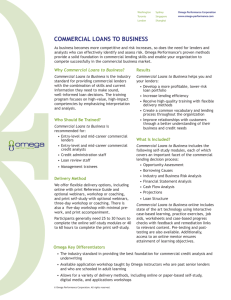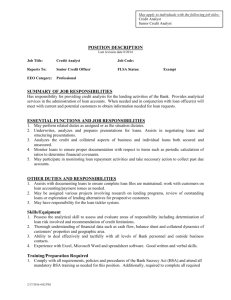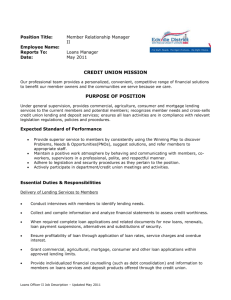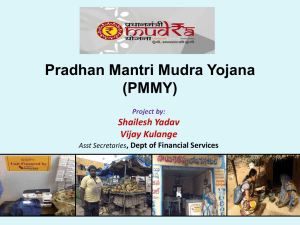2014 Microlenders Forum New Players Panel Tom Green Lending Club
advertisement
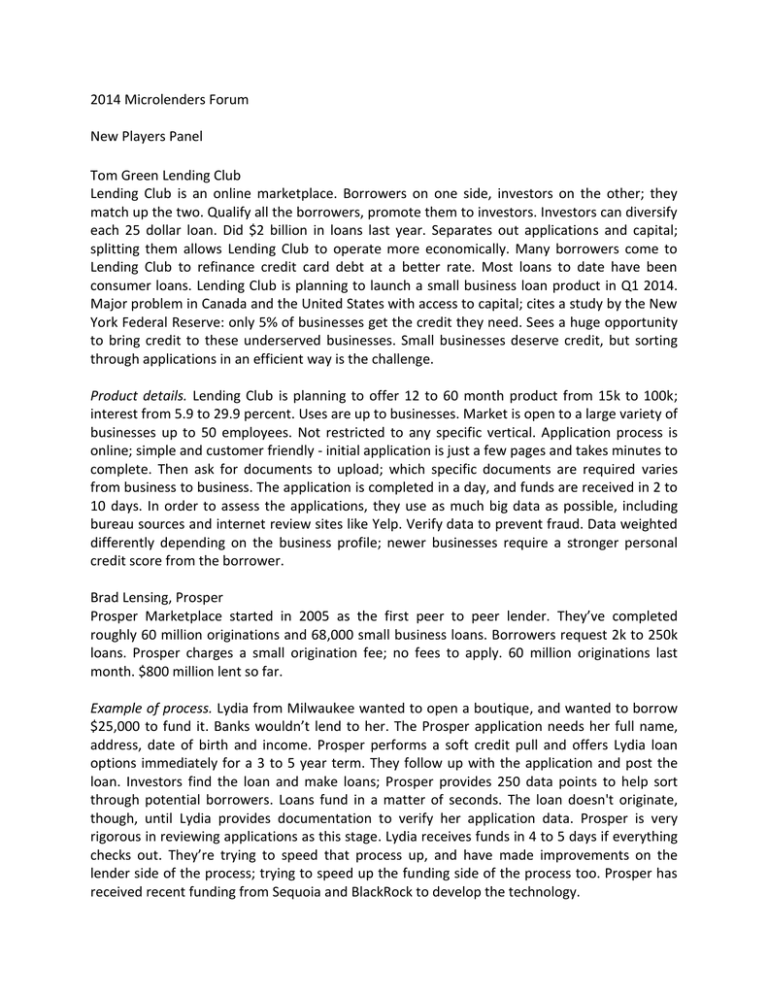
2014 Microlenders Forum New Players Panel Tom Green Lending Club Lending Club is an online marketplace. Borrowers on one side, investors on the other; they match up the two. Qualify all the borrowers, promote them to investors. Investors can diversify each 25 dollar loan. Did $2 billion in loans last year. Separates out applications and capital; splitting them allows Lending Club to operate more economically. Many borrowers come to Lending Club to refinance credit card debt at a better rate. Most loans to date have been consumer loans. Lending Club is planning to launch a small business loan product in Q1 2014. Major problem in Canada and the United States with access to capital; cites a study by the New York Federal Reserve: only 5% of businesses get the credit they need. Sees a huge opportunity to bring credit to these underserved businesses. Small businesses deserve credit, but sorting through applications in an efficient way is the challenge. Product details. Lending Club is planning to offer 12 to 60 month product from 15k to 100k; interest from 5.9 to 29.9 percent. Uses are up to businesses. Market is open to a large variety of businesses up to 50 employees. Not restricted to any specific vertical. Application process is online; simple and customer friendly - initial application is just a few pages and takes minutes to complete. Then ask for documents to upload; which specific documents are required varies from business to business. The application is completed in a day, and funds are received in 2 to 10 days. In order to assess the applications, they use as much big data as possible, including bureau sources and internet review sites like Yelp. Verify data to prevent fraud. Data weighted differently depending on the business profile; newer businesses require a stronger personal credit score from the borrower. Brad Lensing, Prosper Prosper Marketplace started in 2005 as the first peer to peer lender. They’ve completed roughly 60 million originations and 68,000 small business loans. Borrowers request 2k to 250k loans. Prosper charges a small origination fee; no fees to apply. 60 million originations last month. $800 million lent so far. Example of process. Lydia from Milwaukee wanted to open a boutique, and wanted to borrow $25,000 to fund it. Banks wouldn’t lend to her. The Prosper application needs her full name, address, date of birth and income. Prosper performs a soft credit pull and offers Lydia loan options immediately for a 3 to 5 year term. They follow up with the application and post the loan. Investors find the loan and make loans; Prosper provides 250 data points to help sort through potential borrowers. Loans fund in a matter of seconds. The loan doesn't originate, though, until Lydia provides documentation to verify her application data. Prosper is very rigorous in reviewing applications as this stage. Lydia receives funds in 4 to 5 days if everything checks out. They’re trying to speed that process up, and have made improvements on the lender side of the process; trying to speed up the funding side of the process too. Prosper has received recent funding from Sequoia and BlackRock to develop the technology. Leslie Payne, LendUp LendUp only works in personal loans competing with payday loans. The payday lending market is tribal or offshore to avoid regulations to the detriment of the borrowers; LendUp registers in each state where they lend. Payday loans also don't reward good behavior; credit scores do not reflect timely payment. Borrowers move up the LendUp ladder as they repay loans, with the top two tiers reporting timely payment to credit bureaus. Lend to people with bad credit and people with thin credit histories. They use traditional bureau data but also other forms of information including bank information, social media and behavior on the site - what do they read, how long do they spend reading it, etc. LendUp performs one underwriting per person for life. Borrowers qualify for further loans for the points they accrue on the site by paying loans back, making loan payments on time, or by completing credit education courses LendUp offers. First loans are small volume, short term, high-interest loans, but grow in volume and get cheaper as borrowers move up the ladder. The top two tiers are installment loans and ARE reported to credit bureaus. LendUp is Fair Lending Act compliant; their borrowers tend to be female and younger. Applying for a loan takes 5 to 7 minutes in best case scenario but never more than 15 minutes. The decision is instant, while funding can take up to 24 hours. Marketing is almost 100% online. LendUp offers their services at point of purchase too – if a borrower lacks funds to make a purchase, they can instantly apply for a loan and make the purchase. Fees do not roll over if the borrower is unable to pay and notifies LendUp prior to missing a payment. LendUp has been operating for two years, but has only lending since April of 2013. They are currently lending to 3,000 people a month, plus about 3,000 returning users, for 6,000 loans per month. Paul Quintero, Accion East Accion East started doing internet lending in 2005 to scale their work and break the distance barrier. Previously they were limited to regions where they had loan consultants; the internet allowed them to serve areas their consultants couldn't reach. Initially, they just allowed borrowers to submit applications online, and didn’t use any algorithms to evaluate the applications. The 2008 recession changed their model; delinquencies were not substantially increased after shifting models. There’s more risk of identity theft and intentional fraud with online lending, so it is not without its challenges. Accion started lending 50 years ago in Latin America before expanding to the United States. Microlending benefitted early on from the lack of caps on interest rates, allowing lenders to adjust rates to reflect risk levels. The microlending industry is still under- or unregulated. Each state has a different cap on the maximum allowable rate; possibly preventing lending growth? There’s a conflict between the business desires of lenders and the mission of nonprofit lenders. It can sometimes be better to deny a loan than to destroy someone's credit if they are too high of a risk. Accion is therefore unwilling to pursue the same universal acceptance of the other panelists. Accion East only offers term microloans, with a minimum loan amount of $5k in California – though other states might dip down as low as $900 – and a maximum of $50k. On average, Accion’s loans are anywhere from $6,500 to $8,500 with 24 to 60 month terms. Not a collateral lender. Loans are priced like unsecured credit cards, with an 8.9 to 15.9 annual percentage rate. A typical rate is 12 to 13%. Many borrowers are refinancing credit card debt. Accion is seeking a 92% repayment rate, not 100%, and are willing to accept failures to remain open to high need borrowers. Many microlenders do not price loans according to their risk which keeps them underwater – thus higher rates pay for the built-in 8% failure rate. Accion is very clear about why their rates are as high as they are – Paul thinks that's anomalous in the field. They’ve shifted their market focus to aim at specific market segments; increasing competition within the microlending field is encouraging them to define the niche they want to serve. It takes an average of 8 minutes to evaluate an application. Borrowers complete a two page application – that’s the easy part. Collecting the documentation they need takes longer – they rely primarily on bank statements for loans under $10k. Larger loans require tax returns, though he doesn't find tax particularly predictive of repayment success. Repayment rates have widened post-recession, but they are still seeing a 90% repayment rate. Accion has developed a process and an algorithm to adjust interest rates to reflect actual repayment rates – borrowers receive a better rate as repayment improves. They use Microbuild for instant bank verification – allowing loan officers to get documentation within an hour if the borrower permits. Using big data to predict reliable borrowers without accessing credit scores – what he calls business card data (name, address, phone number, email, etc.). The average completion time from initial application in November was 14 days, due primarily to document collection; when the borrower has their documentation ready to go, the average completion is 4.9 days. Discussion Q: Does using their address to evaluate borrowers bias lenders against redlined borrowers? No – panelists are not using addresses to evaluate credit as much as to establish identity and prevent fraud. Agnes Ubalde, Wells Fargo: When you talk about instantaneously funding borrowers, as you collect the data, are you asking for business plans or vision for the company? How are you collecting those, if you are? Accion: No. We measure impact our impact through the Aspen Institute’s microTracker. The survival rate of borrower businesses is 98%. That relationship is maintained postloan; loan consultants follow up with rejected borrowers to educate them about why they failed and how they can improve. Lending Club: No. Business plans aren’t quantifiable for their algorithm. They do require the borrower to write a description of their business, and are working to build textual analysis into the algorithm. Maria Roberts De La Para, Terra Green: How did you develop your models? Accion: Once they developed their scorecard they looked at what they needed to know to make their risk assessment and dropped everything they didn't need to know to make that assessment. Shifting commitment (i.e., saying ‘yes’ to the loan) to before requesting documents increases applicant buy-in. Didn't use an outside group to develop application. Initial application is all about getting to a yes/no valuation immediately. Prosper: Concur. Documents much more likely to come in if borrowers know they'll receive a loan at the end of the process. Barbara Vohryzek, GO-BIZ: (To Lending Club) How soon are you looking at $100k+ loans? Will you move to $2, 3 million? As the yield curve normalizes will you still remain competitive with Wells Fargo, etc.? Lending Club: We ARE regulated. All loans are made by a bank out of Utah. Investors are regulated by SEC. This is a new model for credit. Will probably move up the ladder at some point, but don’t have a specific timeline yet. Should increase over $100k in the next couple of years but could take much longer to hit $1 million. Depends on the partnerships we make. Claudia Viek, CAMEO: You all fund just 10% of applicants. What do you do with the other 90%? Prosper: Credit score floor is 640. Required documentation below that is prohibitive to collect. Lenders are lest interested in funding riskier loans. Don't do much with rejected applicants. Their model changes with second time borrowers, though. Lending Club: Match risk level with pricing. Their big selling point is the ease of the process. They concentrate on their approved borrowers. May develop partnerships with TA providers, but don't have anything currently in place. Accion: Credit floor is 525. Below that it takes too long to close a loan; their scorecard doesn't care about score. Interest rates can't expand beyond the state cap. Borrowers that don't like the rate Accion offers are directed to banks now that they've been screened by Accion. Yvonne Lee, SBA: Accion is unregulated? Small businesses lenders are overregulated - what suggestions do you have to protect borrowers while streamlining process? Accion: Regulatory burdens don't affect their clients much. CDFIs should partner with banks to leverage bank regulatory infrastructure to offer services to wider service area. Let the bank worry about the regulations so CDFI can concentrate on finding lenders. State and federal regulations aren't too burdensome, but municipal regulations can be. Lending Club: There’s good news and bad news: bank partnership doesn't absolve them of regulatory compliance but they see their process as a platform, and offer it to community banks. Banks direct applications to Lending Club and then invest in the loan once Lending Club posts it. Lena Robinson, Federal Reserve: do you all report to credit bureaus? Panel: Yes. Susan Brown, Susan Brown Consulting: is LendUp partnering with community based organizations? LendUp: Yes, in two ways. One, as a referral network, but they’re also open to partnering with organizations who want to lend from their own balance sheet but using LendUp as the platform. All TA is available before creating an application. Very open to partnerships around their education models. Shufina English, CAMEO: Has been an investor for several years but noticed several years ago that she had a high default rate on business loans, so only makes personal loans now. How are you addressing this problem? Lending Club: Some of that is time dependent. 2009 was a bad year due to the recession, and their credit model was fairly rudimentary; both have improved substantially since then. Prior loans were based on personal loan criteria, not business. Accion: personal loans do perform better than business loans. Technology has more of an impact on small loans than large ones. Mark Quinn, SBA: Many attendees are TA-driven, not algorithm-drive. How do you see your relationship to us? Prosper: Complementary. Prosper is merely another product CDFIs can offer. Accion: They’re mission-driven, so Accion is developing online tools to provide level of engagement similar to their offline assistance. Technology is supporting their TA model, not replacing it. Lending Club: Lenders can be either mission-driven, which has a hard time scaling efficiently, or large scale-driven, which is aimed at changing national environment. Don’t see themselves as in competition with older model; Lending Club is a platform CDFIs can use. LendUp: They’re mostly doing personal loans, but she thinks people should access the lowest cost credit they can. See themselves as more in competition with payday lenders, not microlenders. Heidi Pickman, CAMEO: would you consider incorporating a tool that helps provide TA? Lending Club: Certainly, if it doesn't put them out of compliance. Love to incorporate into their model. Prosper: Yes, especially if it helps them make a more informed decision. Bankers Panel Fred Mendez, Rabobank Are microlenders willing to embrace creative destruction? Old models are not going to survive; are you willing to adapt and work with new models and partners moving into the field? Lena Robinson, Federal Reserve Bank of San Francisco Speaking from a regulatory standpoint. High touch-support that microlenders provide is important for business owners, and remains expensive; seems to be suggesting that CDFIs partner with these platforms and shift to a TA centric program model. Banks are gobblers; CDFIs survive as long as they aren't a threat to the larger banks. Potentially destructive of expanding credit to nontraditional borrowers? Maybe. Herman White, SF Fire Credit Union CU started as microlenders because firefighters weren't able to get loans. Expanded since then into the community. Can't compete with online platforms; can't spend millions of dollars to develop new platforms, but can compete on service. Partnering with online lenders to support low-level borrowers. Love to pass referrals back and forth with microborrowers who are ready to move to a larger loan. How do online borrowers work with immigrants and borrowers who aren't comfortable with sharing information online? Rabobank: Online lending is very interesting. View it as a part of the efficient credit process. You only do what you have to do; they brought together largest lenders and paid them to combine their back offices. Sees duplication of basic processes as inefficient and expensive. Many very small lenders need answers as quickly as possible, and the high touch model gets in the way then. Claudia Viek, CAMEO: Who's going to fund all this TA? All the money stays focused on lending, but as you've suggested CDFIs are struggling to compete in that arena. What happens to the 90% of online borrowers who are rejected? Barbara Vohryzek, GO-BIZ CDFIs should shift to fisherman role; lenders pay a referral fee to CDFIs who pass successful applicants on. Shift funding model AWAY from grants to fee-for-service from larger lenders. Federal Reserve: Concur. Always struggled with getting banks to refer to smaller and alternative lenders in a formal way. Banks still not there, even fifteen years later. How are online lenders different? Are they building referral networks and paying relationships with their referrers? Rabobank: Need to shift away from philanthropy as main source of income to self-financing. Services are too important to rely on the capricious generosity of strangers. Not sustainable in the long-term. SF Fire: Grant model is broken and unreliable. TA is in-person only, for now, but tech is narrowing that lead. Rabobank: Trying to develop a model to shift metropolitan money to rural areas; online platforms offer a very powerful model to provide that support.
